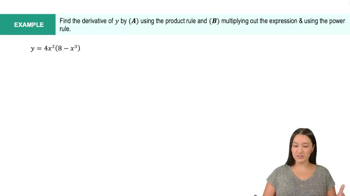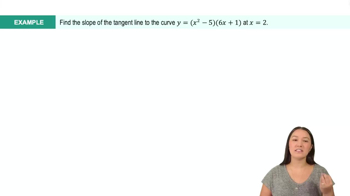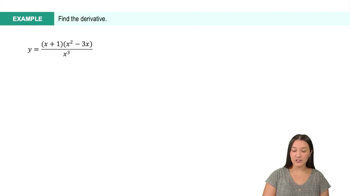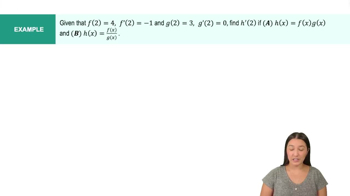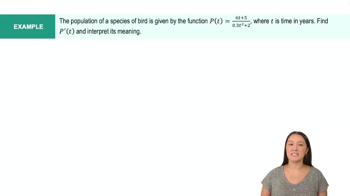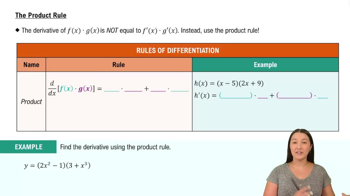Table of contents
- 0. Functions7h 52m
- Introduction to Functions16m
- Piecewise Functions10m
- Properties of Functions9m
- Common Functions1h 8m
- Transformations5m
- Combining Functions27m
- Exponent rules32m
- Exponential Functions28m
- Logarithmic Functions24m
- Properties of Logarithms34m
- Exponential & Logarithmic Equations35m
- Introduction to Trigonometric Functions38m
- Graphs of Trigonometric Functions44m
- Trigonometric Identities47m
- Inverse Trigonometric Functions48m
- 1. Limits and Continuity2h 2m
- 2. Intro to Derivatives1h 33m
- 3. Techniques of Differentiation3h 18m
- 4. Applications of Derivatives2h 38m
- 5. Graphical Applications of Derivatives6h 2m
- 6. Derivatives of Inverse, Exponential, & Logarithmic Functions2h 37m
- 7. Antiderivatives & Indefinite Integrals1h 26m
- 8. Definite Integrals4h 44m
- 9. Graphical Applications of Integrals2h 27m
- 10. Physics Applications of Integrals 2h 22m
3. Techniques of Differentiation
Product and Quotient Rules
Problem 3.4.49
Textbook Question
Derivatives Find and simplify the derivative of the following functions.
g(w) = √w+w / √w-w
 Verified step by step guidance
Verified step by step guidance1
Step 1: Rewrite the function \( g(w) = \frac{\sqrt{w} + w}{\sqrt{w} - w} \) in a form that is easier to differentiate. Consider using the quotient rule, which states that if you have a function \( \frac{u}{v} \), its derivative is \( \frac{u'v - uv'}{v^2} \).
Step 2: Identify \( u = \sqrt{w} + w \) and \( v = \sqrt{w} - w \). Find the derivatives \( u' \) and \( v' \). For \( u = \sqrt{w} + w \), use the derivative rules: \( u' = \frac{1}{2\sqrt{w}} + 1 \). For \( v = \sqrt{w} - w \), use: \( v' = \frac{1}{2\sqrt{w}} - 1 \).
Step 3: Apply the quotient rule: \( g'(w) = \frac{(\frac{1}{2\sqrt{w}} + 1)(\sqrt{w} - w) - (\sqrt{w} + w)(\frac{1}{2\sqrt{w}} - 1)}{(\sqrt{w} - w)^2} \).
Step 4: Simplify the expression in the numerator by distributing and combining like terms. Carefully expand each term and simplify.
Step 5: Simplify the entire expression by combining like terms and reducing the fraction if possible. Ensure that the final expression is in its simplest form.
 Verified video answer for a similar problem:
Verified video answer for a similar problem:This video solution was recommended by our tutors as helpful for the problem above
Video duration:
6mPlay a video:
Was this helpful?
Key Concepts
Here are the essential concepts you must grasp in order to answer the question correctly.
Derivatives
A derivative represents the rate at which a function changes at a given point. It is defined as the limit of the average rate of change of the function as the interval approaches zero. In calculus, derivatives are used to find slopes of tangent lines, optimize functions, and analyze motion. The notation for the derivative of a function f is often written as f'(x) or df/dx.
Recommended video:

Derivatives
Quotient Rule
The Quotient Rule is a method for finding the derivative of a function that is the ratio of two other functions. If you have a function h(x) = f(x)/g(x), the derivative h'(x) is given by (g(x)f'(x) - f(x)g'(x)) / (g(x))^2. This rule is essential when differentiating functions that involve division, ensuring that both the numerator and denominator are correctly accounted for in the derivative.
Recommended video:
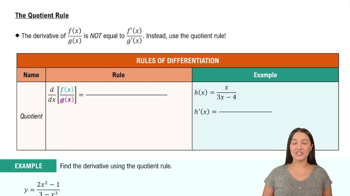
The Quotient Rule
Simplification of Derivatives
Simplifying derivatives involves reducing the expression to its simplest form after differentiation. This can include factoring, canceling common terms, or combining like terms. Simplification is crucial for making the derivative easier to interpret and use in further calculations, such as finding critical points or analyzing the behavior of the function.
Recommended video:

Derivatives
Related Videos
Related Practice



